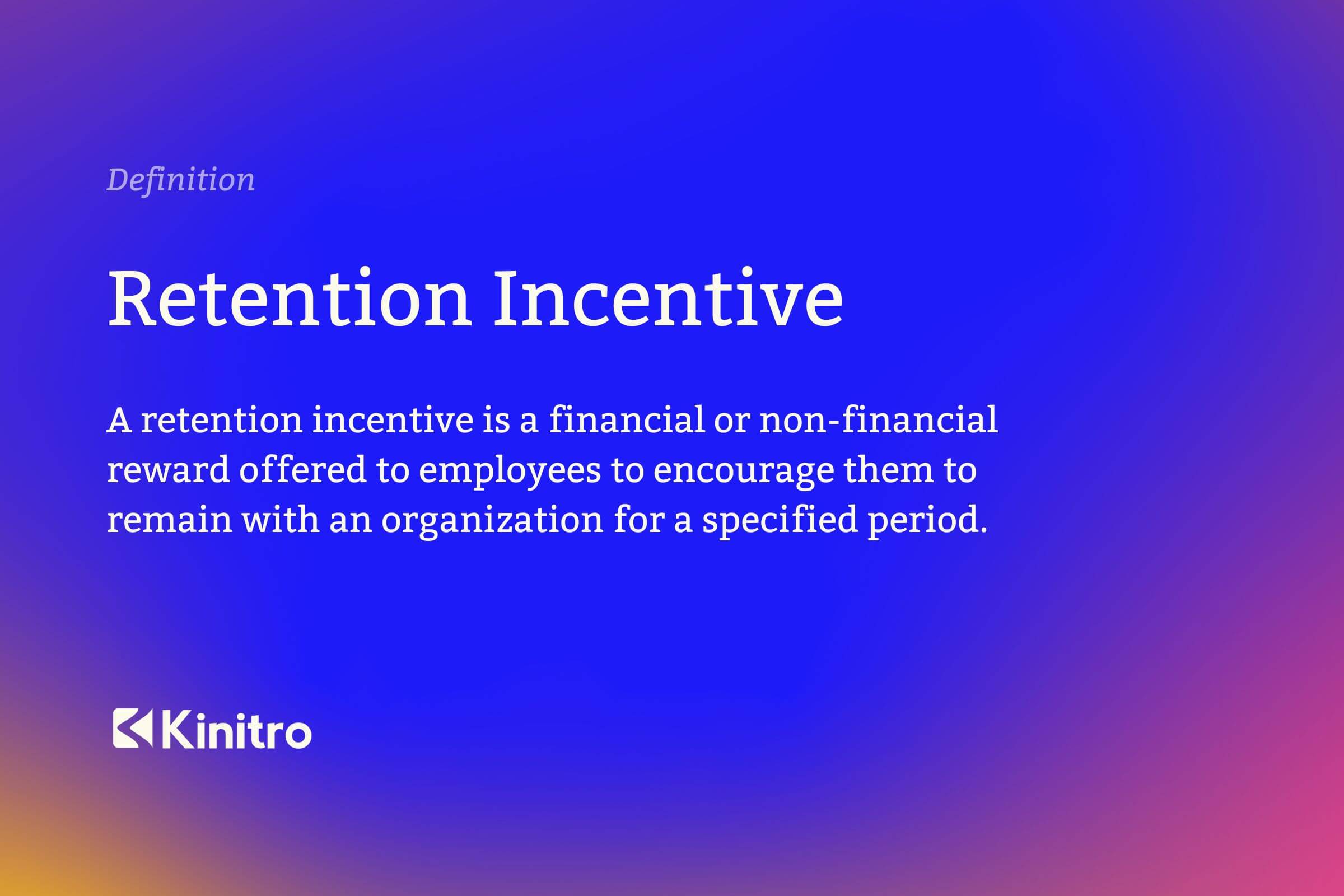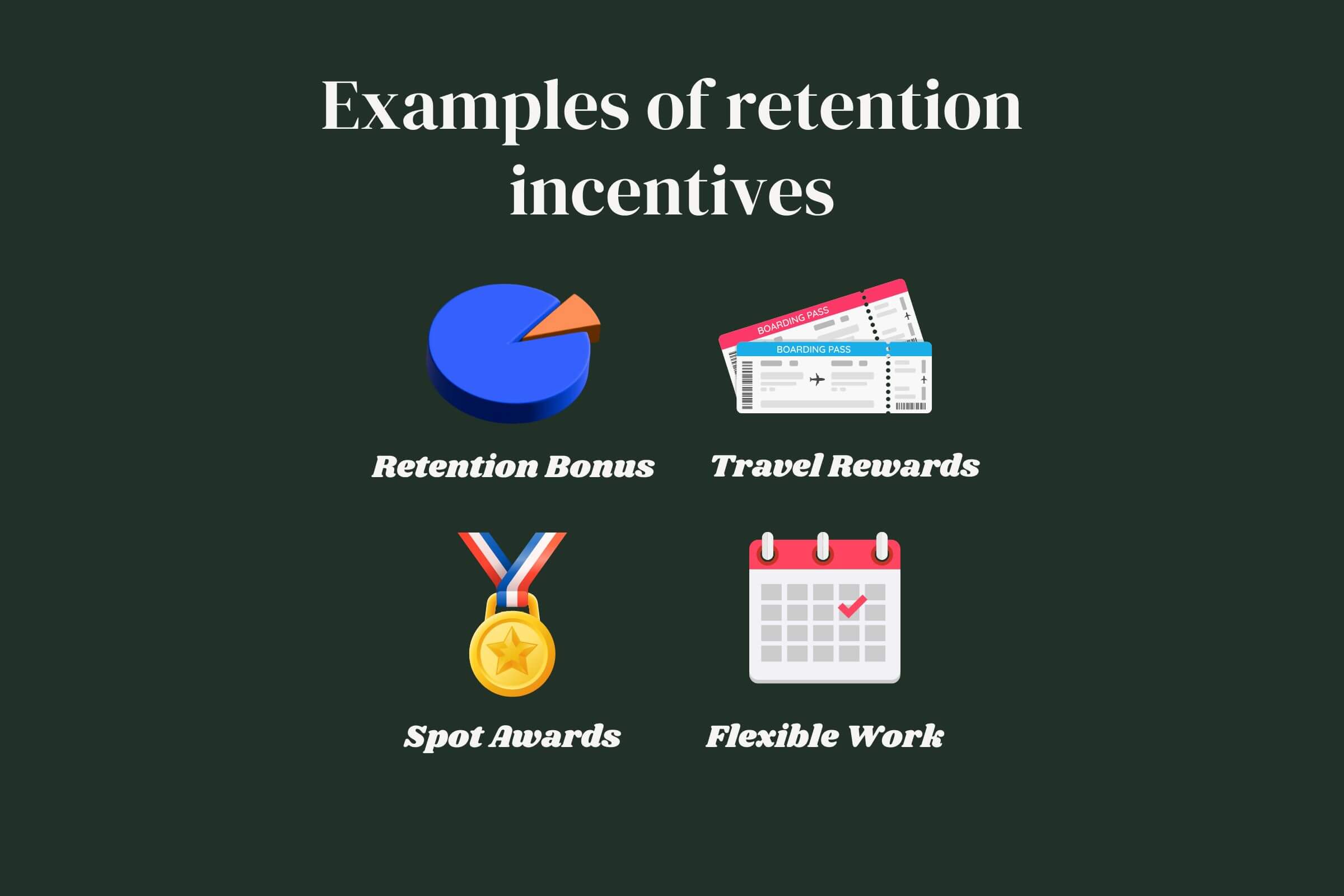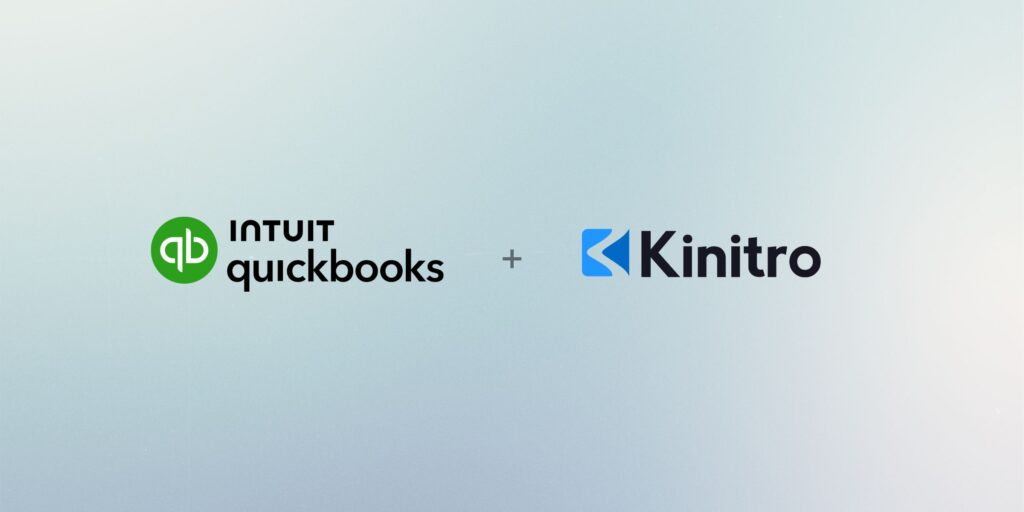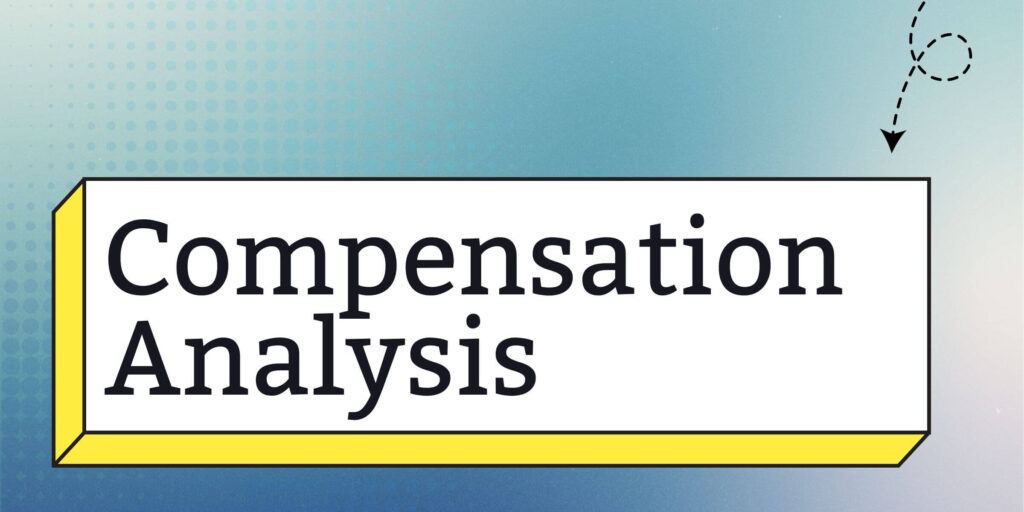Retention incentive programs are essential for companies aiming to reduce turnover and retain top talent. These programs involve financial rewards, benefits, and growth opportunities that motivate employees to stay.
In this article, you’ll learn how retention incentive programs work, their key elements, and the best practices for implementation.
Key Takeaways
- Retention incentive programs are designed to improve employee retention by offering financial and non-financial rewards to key employees, particularly during organizational changes.
- A successful retention incentive program requires clear eligibility criteria, a structured payment plan, and tailored incentives that align with employee needs and organizational goals.
- Companies that effectively implement retention incentives not only enhance employee morale and loyalty but also reduce recruitment costs and preserve essential institutional knowledge.
Understanding Retention Incentive Programs
Retention incentives refer to incentives offered to retain employees within an organization. These incentives are designed to improve employee retention by encouraging key employees to stay, especially during times of organizational change or restructuring.
Whether it’s a financial retention bonus or non-financial perks, the primary goal is to address turnover and foster a sense of loyalty and commitment among employees.
Retention incentive programs are particularly effective when they resonate as meaningful and valuable to employees. For instance, a retention bonus can significantly enhance employee morale by making employees feel appreciated and recognized for their contributions.
Typically, these programs target executives and highly skilled workers whose departure could have a substantial impact on the organization.
As we move forward, we will explore the key elements that make these programs successful and the various types of incentives that can be offered.

Key Elements of Retention Incentive Programs
To establish a successful retention incentive program, certain key elements must be in place.
One of the most critical components is the written service agreement that employees must sign to be eligible for a retention incentive. This agreement typically includes details about eligibility, payment structures, and the terms of the incentive, ensuring that both the employer and the employee are clear about the expectations and commitments involved.
Documentation and record keeping are also essential aspects of a retention incentive plan. Employers must meet specific documentation requirements as stipulated in the plan, including how retention incentives are documented and reported. This level of detail ensures transparency and accountability, making it easier to track the program’s effectiveness and make necessary adjustments over time.
By including common points related to eligibility, payment structures, and terms in the retention bonus agreements, companies can create a structured and reliable framework for their retention incentive programs.
Types of Retention Incentives
Retention incentives come in various forms, each designed to meet different employee needs and organizational goals.
One of the most common types is the retention bonus, a financial incentive offered to persuade an employee to remain with a company.
These bonuses typically range from 10% to 25% of the employee’s annual compensation, providing a significant financial reward for staying with the organization.
However, not all retention incentives are financial. Non-financial incentives can also play a crucial role in retaining employees. Here are some examples:
- Career development opportunities such as training programs and workshops, which can be highly motivating for employees seeking growth and advancement in their careers
- Flexible work arrangements
- Spot bonuses for outstanding performance
- Travel rewards
All of these can contribute to higher job satisfaction and loyalty.
By offering a mix of financial and non-financial incentives, companies can create a comprehensive retention strategy that addresses the diverse needs of their workforce.
This approach not only helps in retaining key employees but also fosters a positive and engaging work environment.
As we move forward, we will explore the eligibility criteria for these incentives and how companies can ensure that they are targeting the right employees.

Eligibility Criteria for Retention Incentives
Eligibility criteria for retention incentives are crucial in determining which employees qualify for these programs.
Typically, payment of retention incentives is contingent on an employee having a performance rating of at least ‘Fully Successful’ under official evaluation systems.
In the following subsections, we will delve deeper into the criteria for high-demand positions and performance-based eligibility.
High-Demand Positions
High-demand positions often require specialized knowledge and unique qualifications, making them vital for maintaining an organization’s competitiveness and stability.
For example, cybersecurity professionals are frequently targeted for retention incentives due to the critical nature of their roles and the high demand for their expertise in the job market.
By implementing retention incentives for these positions, companies can mitigate the risk of turnover and retain essential talent.
These incentives are not only beneficial for the organization but also for the employees in high-demand positions. They provide a sense of security and recognition, making employees feel valued and appreciated for their specialized skills.
Performance-Based Eligibility
Performance-based eligibility is another critical factor in determining who qualifies for retention incentives.
Performance evaluations play a crucial role in assessing employee contributions and aligning their goals with organizational objectives. Effective performance evaluations not only provide structured feedback but also enhance employee engagement and productivity.
Retention incentives are often tied to performance evaluations, with higher-performing employees having a better chance of qualifying for such incentives. Companies may set specific performance thresholds that employees must meet or exceed to be considered for retention incentives.
This approach fosters a meritocratic culture, encouraging employees to maintain consistent high performance and contributing to a culture of accountability.
Ultimately, performance-based eligibility for retention incentives leads to increased employee retention and morale.
Crafting Effective Retention Incentive Packages
Crafting effective retention incentive packages requires a strategic approach that caters to both the organization’s and the employees’ needs.
A company must establish a retention incentive plan before offering incentives, including documentation of employee qualifications and justifications for retention needs. Tailoring the incentives to the specific roles and performance of employees increases their perceived fairness and effectiveness.
It’s essential to avoid a one-size-fits-all approach to retention incentives. Customization is key to ensuring that the incentives resonate with employees and positively impact retention.
HR should understand employee needs when crafting retention incentives, ensuring they are meaningful and relevant. Offering a personal learning budget, for example, can encourage ongoing development and loyalty among employees.
Additionally, including non-monetary rewards like development opportunities and profit-sharing plans can motivate employees and enhance job satisfaction.
Clear communication about the bonus program helps manage employee expectations and prevent misunderstandings. HR should fulfill promises made in the incentive program to build trust and maintain employee morale.
Regularly monitoring and updating retention incentives ensures they remain relevant to both the company and employees.
By incorporating employee feedback and making necessary adjustments, companies can create a dynamic and effective retention incentive program.
Payment Structures for Retention Incentives
Retention incentives can be paid in various forms, each with its own set of advantages and drawbacks.
One common approach is to offer retention bonuses as a single lump sum payment or distributed in smaller amounts over a set period. A lump sum payment provides immediate financial reward, while incremental payments can maintain employee motivation throughout the agreed duration.
The choice of payment structure depends on the company’s goals and the preferences of the employees. By strategically planning the payment structure, companies can ensure that the incentives serve their purpose of retaining employees and maintaining a motivated workforce.
Tax Implications of Retention Incentives
Understanding the tax implications of retention incentives is essential for both employers and employees.
Retention bonuses are treated as taxable income by the IRS, with a flat rate of 22% for amounts below $1 million. Any retention bonus amount exceeding $1 million is taxed at a higher rate of 37%.
Employers must deduct the tax amount from retention bonuses, ensuring compliance with tax laws and regulations.
The aggregate method of tax withholding for retention bonuses combines the bonus with the regular salary for tax calculation. This method can impact the overall tax liability for employees, making it important for both parties to understand the tax implications thoroughly.
By being aware of these tax considerations, employers and employees can effectively manage the financial aspects of retention incentives.
Benefits of Retention Incentive Programs
Retention incentive programs offer numerous benefits for both employers and employees. The primary aim of these programs is to keep employees satisfied and reduce turnover, ultimately leading to a more stable and productive workforce.
In the following subsections, we will explore the specific benefits for employers and employees in detail.
Employer Benefits
For employers, the benefits of retention incentives are manifold.
One of the most significant advantages is the reduction in costs associated with recruitment and onboarding new staff. Paying a retention bonus may be less expensive than hiring a new employee, making it a cost-effective strategy for retaining key talent.
Additionally, retention incentives help preserve institutional knowledge by encouraging skilled professionals to stay, maintaining continuity of work and enhancing employee satisfaction.
Retention incentives also enhance recruiting efforts, as the promise of such incentives can attract high-quality candidates. By offering competitive salary packages and benefits, companies can mitigate the risk of losing employees to competitors. Additionally, a relocation incentive can further entice potential candidates to join the organization.
Ultimately, the primary benefit for employers offering a retention bonus is the retention of the employee, which contributes to a more productive and engaged workforce.
Employee Benefits
For employees, retention incentives provide financial stability, reducing their financial stress and anxiety. This financial security makes employees feel more secure in their roles, improving overall loyalty to the company.
Additionally, offering professional development opportunities and flexible work arrangements greatly enhances job satisfaction for employees, making them more likely to stay with the organization. Maintaining a healthy work-life balance and providing recognition positively influences employee morale.
The cumulative effect of retention incentives fosters a supportive workplace culture, ensuring employees feel valued and appreciated. This supportive environment not only boosts employee morale but also contributes to higher retention rates and a more engaged workforce.
Strategies for Implementing Retention Incentive Programs
Implementing retention incentive programs requires a strategic approach that involves understanding employee needs and preferences.
Companies should ask employees about their needs and preferences to tailor retention incentives effectively.
Involving employees in the development of retention strategies can enhance their engagement and satisfaction. Regular feedback through stay interviews can guide adjustments to retention strategies, ensuring they remain relevant and effective.
Clear communication about the retention incentive program fosters transparency and trust among employees, making them more likely to engage with the program.
Utilizing HR analytics assists in pinpointing factors that influence employee satisfaction and attrition, helping companies make data-driven decisions. Innovative strategies such as wellness leave and remote work flexibility can significantly improve employee retention.
By regularly evaluating the effectiveness of retention incentives and gathering employee feedback, companies can create a dynamic and effective retention strategy.
Measuring the Success of Retention Incentive Programs
Measuring the success of retention incentive programs is crucial for understanding their impact and making necessary adjustments.
One effective way to measure success is by using employee feedback and turnover rates. Conducting surveys can provide valuable insights into employee satisfaction and identify areas needing improvement. Regular assessment of program outcomes will lead to enhanced strategies and increased employee retention.
Another essential metric is the retention ROI, which offers a financial perspective on the benefits of retaining employees against the costs incurred. By comparing retention rates before and after the implementation of retention plans, companies can evaluate their impact and make data-driven decisions for future improvements.
Common Challenges and Solutions
Implementing retention incentive programs can present various challenges that organizations must navigate to maximize effectiveness.
One common challenge is the financial impact of retention bonuses, which should be carefully evaluated to ensure they do not create employee discord. Poor hiring practices can also lead to high turnover, emphasizing the need for focusing on cultural fit during recruitment.
Another challenge is keeping track of revisions or modifications that impact retention incentives, ensuring compliance with tax regulations. Developing a comprehensive and well-documented retention incentive plan can help address these challenges and ensure a smooth implementation process.
Clear communication and employee feedback are essential for overcoming these challenges. By involving employees in the development of retention strategies and regularly evaluating their effectiveness, companies can create a dynamic and responsive retention incentive program.
Utilizing HR analytics and performance metrics can also provide valuable insights into the factors influencing employee satisfaction and attrition. By leveraging these tools and strategies, organizations can navigate the common challenges and achieve higher retention rates.
Real-World Examples of Retention Incentive Programs
Real-world examples of successful retention incentive programs can provide valuable insights and inspiration for organizations looking to implement similar strategies.
Here are some ideas across different sectors:
1. Technology
- Scenario: A tech company is in the final stages of launching a major product that requires the expertise of senior software developers.
- Example: The company offers developers a $15,000 retention bonus to remain until the product is successfully launched and stabilized over six months.
2. Retail
- Scenario: A major retail chain faces peak demand during the holiday season and risks losing staff to competitors.
- Example: Seasonal employees who commit to working through the holiday season receive a $500 bonus at the end of the period.
3. Manufacturing
- Scenario: A factory producing automotive parts has a large, time-sensitive order and needs experienced machinists to maintain productivity.
- Example: Machinists receive a $2,000 bonus if they stay through the order’s completion, reducing turnover and ensuring timely delivery.
4. Hospitality
- Scenario: A hotel chain faces high turnover during peak tourist season, which could lead to service issues.
- Example: Hotel staff, particularly housekeeping and front desk personnel, are offered a $1,000 bonus for staying through the summer season.
5. Finance
- Scenario: A bank is implementing a complex system upgrade that requires specialized knowledge from senior analysts.
- Example: Senior analysts are offered a $20,000 retention bonus to stay until the system upgrade is fully operational.
Summary
In summary, retention incentive programs are a powerful tool for organizations aiming to retain their top talent and maintain a motivated workforce. By understanding the key elements, types, and eligibility criteria for retention incentives, companies can design effective programs that cater to the unique needs of their employees.
The benefits of retention incentive programs extend to both employers and employees, resulting in reduced turnover, increased job satisfaction, and a more productive work environment.
By measuring the success of retention initiatives, companies can optimize their retention incentive programs and create a thriving work environment.
Frequently Asked Questions
What are retention incentives?
Retention incentives are rewards provided to employees to encourage them to remain with an organization, ultimately enhancing employee retention and minimizing turnover.
What types of retention incentives can companies offer?
Companies can effectively retain employees by offering financial incentives, such as retention bonuses, alongside non-financial incentives like career development opportunities and flexible work arrangements. This combination addresses both monetary needs and personal growth aspirations.
How do performance evaluations impact eligibility for retention incentives?
Performance evaluations significantly impact eligibility for retention incentives; employees with higher performance ratings are more likely to qualify for these incentives. Ultimately, consistent high performance enhances an employee’s chances of receiving retention benefits.
What are the tax implications of retention bonuses for employees?
Retention bonuses are subject to taxation as ordinary income, with the IRS applying a flat rate of 22% for amounts under $1 million and 37% for amounts exceeding that threshold. It is essential for employees to factor in this tax liability when evaluating their total compensation.
How can companies measure the success of their retention incentive programs?
To effectively measure the success of retention incentive programs, companies should focus on metrics such as employee feedback, turnover rates, and retention ROI, as these provide valuable insights for future enhancements.







